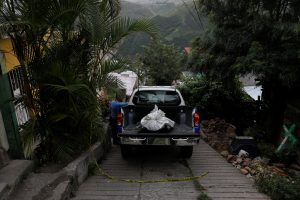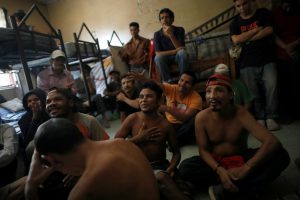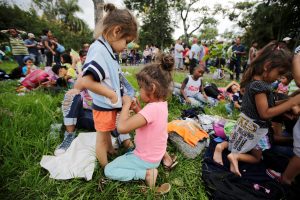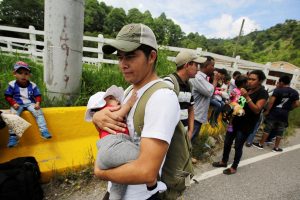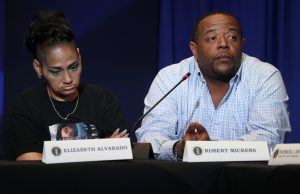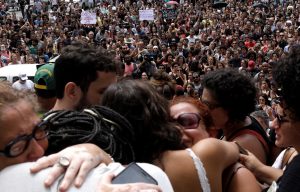
By Jose Cabezas and Nelson Renteria
SAN FRANCISCO GOTERA, El Salvador (Reuters) – Pastor Manuel Rivera’s voice echoes through the crowded courtyard in the notorious San Francisco Gotera prison in El Salvador, as hardened criminals weep and bow their heads in prayer.
Brutal ‘mara’ street gangs and chronic poverty have made El Salvador one of the most murderous countries on the planet, but the growth of evangelical Christianity behind bars is giving gangsters a way to break the spiral of violence.
Rivera, an ex-hitman from the powerful Barrio 18 gang, speaks to rows of men with spidery black tattoos on their arms, necks and faces, delivering a message of salvation: God had rescued them from violence. Returning to gang life would mean death.
“We used to say that the gang was our family, but God took the blindfold off our eyes,” says Rivera, 36, dressed like the other inmates in a white t-shirt, shorts and plastic sandals.
Some weep silently while he reads from a black bible. Others sing hymns, clapping and waving arms enthusiastically. They chorus: “Amen.”
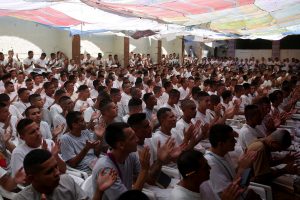
Former members of the Barrio 18 gang participate in a religious service of the Torre Fuerte (Strong Tower) church inside the San Francisco Gotera prison, in San Francisco Gotera, El Salvador, March 9, 2018. REUTERS/Jose Cabezas
By embracing religion, these men can leave their gangs without retaliation, Rivera says. But if they do not show real devotion, their former gang-mates may kill them, fearing they will join other gangs and become enemies.
Convicted murderer Rivera’s own transformation came behind bars, when, battered by years of running from police and enemy gangs, unable to see his son, he turned to prayer.
When God appeared in a dream, prophesying Rivera would have his own flock, he became a pastor, he says. He is now half-way through an eight-year sentence for criminal association.
Evangelical Christianity has grown rapidly in Central America in the past decade, coloring local politics. Dozens of lawmakers embrace it, defending hardline positions against gay rights and abortion.
The fervor has spilled into jails, where it is welcomed by officials who sense its potential for reforming ex-gangsters.
President Salvador Sanchez Ceren’s government plans to use Gotera as a model of religious rehabilitation it hopes can be replicated.
Two years ago the prison, located about 100 miles (166 km) east of capital San Salvador, was almost entirely home to active gang members. Now, the majority of its approximately 1,500 inmates want to find redemption, says prison director Oscar Benavides.
The conversions “show the country that it is possible to rehabilitate those in the Mara Salvatrucha or other gangs,” says Security Minister Mauricio Ramirez, dismissing criticisms that the government should do more.
The Mara Salvatrucha, a notorious cross-border crime group also known as MS-13, was founded by Salvadorans in Los Angeles in the 1980s.
President Donald Trump has blamed MS-13 and illegal immigration from Central America as a major source of violence in the United States.
Outside the relative tranquility of the prison, danger permeates the streets of El Salvador.
Crime has fallen from a record high in 2015, but at 60 per 100,000 inhabitants last year, the murder rate is still one of the highest worldwide.
Inside Gotera, where some inmates are serving 100-year sentences for accumulated crimes, colorful drawings of angels and prophets decorate the walls alongside biblical quotations.
Inmates wearing shirts emblazoned with “Soldier of Christ” and “Jesus Saved My Life” study prayer books, weave hammocks and tend to a garden.
Rodolfo Cornejo, 34, with intricate black tattoos circling his neck, started praying and growing cucumbers when he entered the prison on a 12-year sentence for carrying firearms, wanting to leave the rough life that had isolated him from his kids.
“People on the outside don’t trust us very much: they think we can’t change. But yes, we can show them.”
Click on https://reut.rs/2HJg8kN to see a related photo essay.
(Reporting by Nelson Renteria; Writing by Daina Beth Solomon; Editing by Frank Jack Daniel and Rosalba O’Brien)


